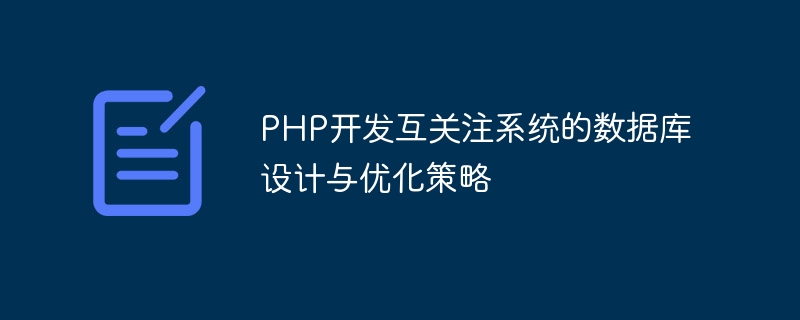
Database design and optimization strategy for PHP development of mutual attention system
With the rise of social networks, people pay more and more attention to their interpersonal relationships in the online world. In order to meet users' needs for social interaction, we decided to develop a mutual following system. In this system, users can follow other users and receive dynamic updates from the followed users. In order to ensure the performance and scalability of the system, we need to pay attention to the design and optimization of the database.
When designing the database of the mutual attention system, we need to consider the following aspects:
- Design of the user table:
The user table is one of the core tables of the mutual attention system First, it records the user's basic information, such as user id, user name, password, etc. In order to improve query efficiency, you can add an index to the user ID field. In addition, in order to facilitate the relationship management between users, a new field can be added to the user table to record the number of followers and fans of the user.
- Design of the following relationship table:
The following relationship table is used to record the following relationship between users, including the follower id and the followed id. In order to improve query efficiency, these two fields can be set as a combined index. Considering that users may frequently follow and unfollow other users, we can add a timestamp field to the following relationship table to record the time of following. This makes it easier for us to query the latest users we follow.
- Design of dynamic table:
Dynamic table is used to record the user's dynamic updates, including dynamic id, content, publisher id, publishing time, etc. In order to improve query efficiency, you can create separate indexes for the publisher id and publishing time fields. Considering that there may be a large amount of dynamic data in the system, we can consider using separate tables or partitions to store dynamic data to avoid query performance degradation caused by excessive data volume in a single table.
-
Optimization strategy of database:
In order to improve the performance and scalability of the database, we can adopt the following optimization strategy:
- Reasonable use of indexes: in the design table When constructing the query, select appropriate fields and add indexes based on the characteristics of the query to reduce the time complexity of the query.
- Database sub-database and sub-table: When the amount of data is too large, you can consider using sub-database and sub-table to store the data in multiple databases or tables to improve query efficiency.
- Database caching: Cache frequently queried data to reduce access to the database and improve system response speed.
- Asynchronous processing: For some time-consuming operations, you can put them into the message queue for asynchronous processing to reduce the load pressure on the database.
To sum up, the database design and optimization strategy for PHP development of mutual attention systems need to consider the design of user tables, the design of attention relationship tables, and the design of dynamic tables. In terms of database optimization, we can use strategies such as rational use of indexes, database sharding, database caching, and asynchronous processing to improve system performance and scalability. Through reasonable database design and optimization strategies, we can provide users with an efficient and stable mutual attention system.
The above is the detailed content of Database design and optimization strategies for developing mutual attention systems in PHP. For more information, please follow other related articles on the PHP Chinese website!

